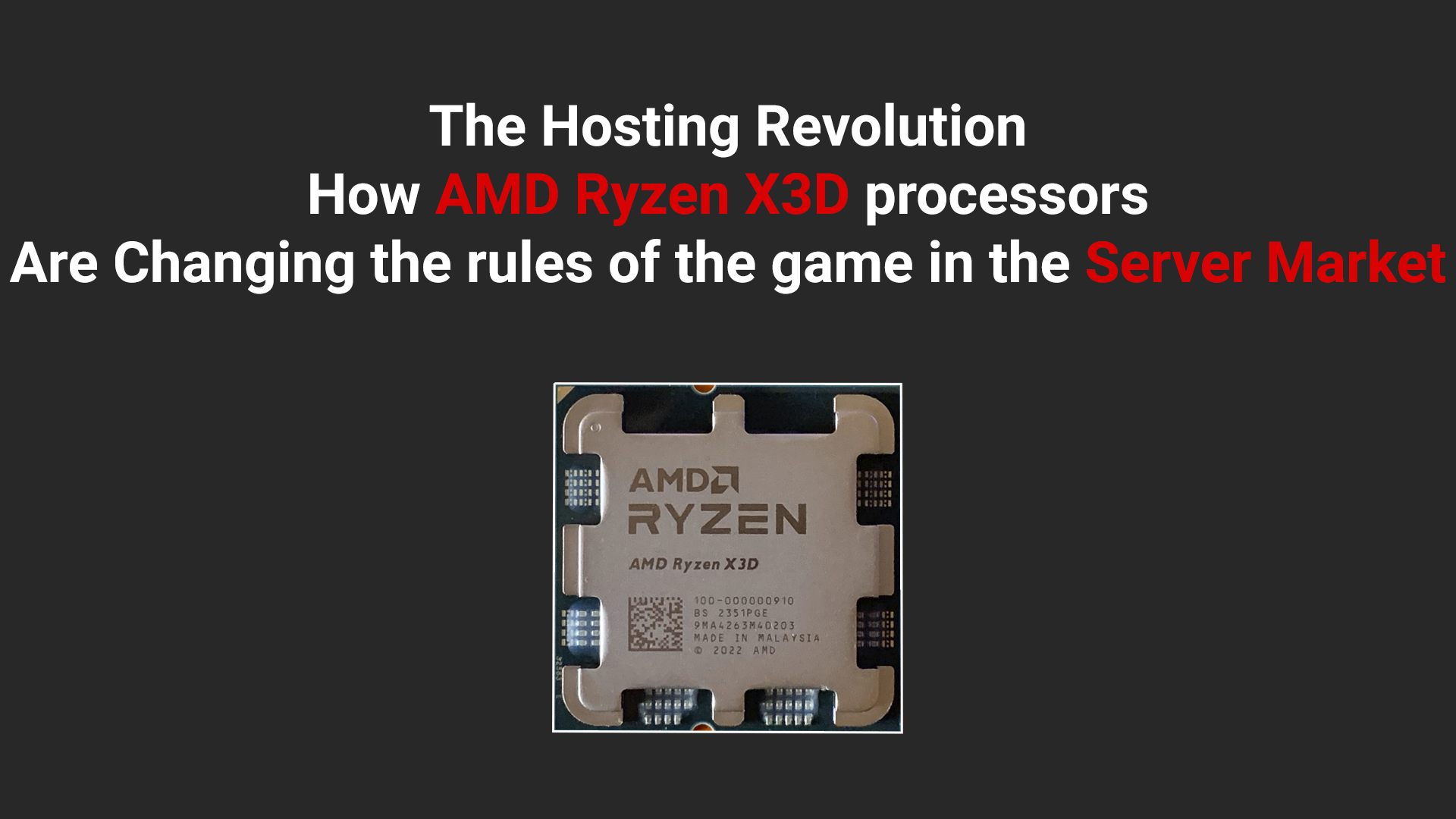A brief overview
Processors with 3D V-Cache are a breakthrough that is still not fully appreciated in society.
If you are a gamer, then you need this processor because it increases FPS and reduces latency in games where every second counts (for example, CS2).
If you are going to create a server where speed is important, you also need this processor due to fewer RAM calls and high performance.
If you are a streamer or engaged in rendering (Video editing or animation in Blender), then a processor with this function will be a very useful and profitable purchase due to the reduced TDP and superiority over conventional processors.
In general, processors with the 3D V-Cache function are increasingly occupying people's hearts and are becoming indispensable when you are looking for performance. A more detailed review is below, have fun reading!
Introduction: The Race for productivity in the world of digital services
Nowadays, when digital services and applications have become an integral part of everyday life, the requirements for server infrastructure are constantly increasing. Game server owners, developers, and system administrators are faced with the need to ensure maximum performance and minimal delays for their projects. Traditional metrics such as the number of cores and the base clock frequency are no longer the only indicator of processor efficiency, and today we will talk about very important characteristics. Increasingly, the speed of data access is becoming a bottleneck, especially in latency-sensitive applications such as online games.
In response to these challenges, AMD has introduced the revolutionary 3D V-Cache technology, which takes Ryzen processors to a leading position in the market. This innovation represents not just an evolutionary improvement, but an engineering breakthrough offering a unique solution to overcome traditional performance constraints. Using 3DV-Cache on a regular PC greatly simplifies video rendering, streaming, and greatly increases FPS in games due to increased cache.
This article will provide a detailed analysis of AMD 3D V-Cache technology, an analysis of its actual performance using the example of hosting game servers, and a comparison with key competitors. In conclusion, it will be shown how the hosting provider Mivocloud uses Ryzen processors to provide high-performance VDS servers in the USA, providing its customers with a competitive advantage.
The foundation of Leadership: Decoding AMD 3D V-Cache technology
To fully appreciate the significance of the 3D V-Cache, you must first understand the structure of the processor's cache memory. It can be represented as a hierarchical structure, where each level performs its role in ensuring fast data delivery to computing cores. Random access memory (RAM) is a huge but relatively slow "national warehouse" of data. The L3 cache is a "regional distribution center" that stores frequently used data and is significantly faster than RAM. Personally, I have a Ryzen 7 7700x processor installed in my PC, which has 32MB of L3 cache, which is certainly quite good and the processor itself is good, but in the future I will definitely take it with 3D v-cache because It provides a significant boost in gaming and video rendering. The L2 and L1 cache are the "desktop" of the processor, where data is available almost instantly. The more data can be stored in faster cache levels, the less often the processor has to access slow RAM, which dramatically increases the overall computing speed.
However, increasing the cache memory has always been associated with serious physical limitations. The traditional "flat" (2D) processor design, in which all components are placed on the same level, does not allow infinite expansion of the cache area without increasing the overall size of the chip. This leads to higher production costs, higher energy consumption and, most importantly, increased delays in data access, as the electrons have to travel a longer distance.
AMD overcame this limitation with vertical stacking. 3D V-Cache technology made it possible to place an additional L3 cache chip directly above the computing cores. This engineering solution not only significantly increases the cache size, in some cases tripling it, but also reduces the physical distance between the cores and the cache. Silicon transition ports (TSV) are used to connect the layers, which provide high-speed data transmission with minimal delays.
Thus, the 3D V-Cache technology is not just a marketing name, but a direct response to the fundamental physical and engineering limitations facing the industry. It demonstrates AMD's strategic vision to address real-world performance challenges, not just the gigahertz race. Personally, in my opinion, this shows why AMD is leading the processor market and has already strongly rejected competitors. Increasing the cache to 128 MB in processors such as the Ryzen 9 7950X3D drastically reduces the time required to access data and significantly improves performance in tasks where memory access speed is critical. And if you are looking for a processor for games, then the Ryzen 7 7800X3D will be the best solution. This processor has been considered the best processor for gaming for more than six months.
Facts and figures: Why Ryzen X3D is the leader in practice, not just on paper
3D V-Cache technology finds its most striking application in an area where every millisecond is important — in games. Game engines are constantly accessing large amounts of data, such as NPC artificial intelligence, physics calculations, and texture processing. The huge L3 cache in X3D processors allows you to store this data "at hand", reducing the number of accesses to slow RAM. This results in a more stable frame rate (FPS) and significantly reduced latency, especially in resource-intensive open-world games and in scenes with a large number of players. In games like Baldur's Gate 3 or Microsoft Flight Simulator, X3D processors show a noticeable advantage. However, it should be noted that in some less demanding or poorly optimized cash games, the difference may be minimal. It is also worth understanding that if you play shooters where every second is important (For example, CS2), then a processor with an X3D cache is your choice because It significantly increases FPS and response time.
Game servers are a perfect example of how 3D V-Cache solves specific problems. For example, the core of the Minecraft game is predominantly single-threaded, and its performance directly depends on the speed of a single computing thread. This makes it extremely sensitive to memory access delays. When the server processes the logic of the game, the loading of chunks, and the operation of hundreds of modifications for a large number of players, the CPU load becomes very high. This is where the huge L3 cache in X3D processors demonstrates its superiority, speeding up the processing of this data and preventing lags and "freezes" that often occur under heavy load.
In direct competition with Intel's flagship, the Core i9-14900K, the AMD Ryzen 9 7950X3D processor shows itself not only as a worthy competitor, but also as a strategically more profitable solution for hosting providers. Although Intel may perform slightly better in synthetic single-threaded tests, the Ryzen 9 7950X3D wins in multithreaded tasks and offers a much larger cache volume, which is critical for game servers. This is why AMD processors are more profitable.
An important factor determining the choice in favor of AMD is stability and energy efficiency. Intel processors of the 13th and 14th generations, despite their high performance, are known in the community for problems with stability and extremely high power consumption, which can lead to malfunctions, especially under constant load. In contrast, Ryzen X3D processors are characterized by excellent energy efficiency (TDP 120 watts versus 125 watts for Intel) and reliability, which makes them an ideal choice for server equipment where continuous operation (uptime) is a critical indicator.
Thus, AMD's leadership in the gaming processor market is explained not only by its high performance in benchmarks, but also by its reputation for reliability and stability. For hosting, where total cost of ownership (TCO) and uninterrupted operation are top priorities, opting for an energy—efficient and reliable X3D processor becomes economically and strategically justified.
Comparison of AMD Ryzen 9 7950X3D and Intel Core i9-14900K
The table below clearly demonstrates how the key characteristics of these two flagship processors relate to each other. The data is based on PassMark benchmarks, which include an extensive database of thousands of results.
| Parameter | AMD Ryzen 9 7950X3D | Intel Core i9-14900K |
| Cores/Threads | 16/32 | 24/32 |
| Base Frequency | 4.2 GH | 3.2 GHz |
| Turbo Frequency | Up to 5.7 GHz | Up to 6.0 GHz |
| Cache L3 | 128 MB | 36 MB |
| TDP | 120 Watts | 125 Watts |
| Performance (Single-Threaded) | 4145 | 4695 |
| Performance (MultiThreaded) | 62361 | 58616 |
| Price, USD | 620.99 | 438.98 |
Table 1: Comparison of AMD Ryzen 9 7950X3D and Intel Core i9-14900K according to PassMark data
As can be seen from the table, the Ryzen 7950X3D demonstrates excellence in multithreaded performance and has a huge amount of L3 cache, which is a direct result of 3D V-Cache technology. This shows that AMD is focusing on a qualitative leap in architecture, rather than just increasing the number of cores. A small concession in terms of insurance due to the increased Cache is logical and justified.
Your decision to win: VDS on Ryzen from Mivocloud in the USA
In a world where competition in the digital environment is growing every day, choosing the right hosting can be a crucial success factor. We offer VDS servers based on AMD Ryzen X3D processors in the USA, which represent the perfect combination of advanced technology, reliability and expert support.
Key features and benefits:
- AMD Ryzen 9 7950X3D processors: A guarantee of the best performance in gaming and cache-dependent tasks. The huge volume of the L3 cache allows you to process large data streams with minimal latency, which is critical for multiplayer games and complex applications.
- Servers in the USA (Oregon): Hosting servers in the United States ensures minimal latency for the audience in North America, which is especially important for game servers where ping is crucial.
- INSTANT SETUP: The server will be ready to work immediately after payment, which allows you not to waste valuable time waiting and immediately start implementing your projects.
- Flexible configuration and hourly payment: Mivocloud offers a flexible tariff system with the possibility of hourly payment, which makes the use of VDS cost-effective and allows you to scale resources (CPU, RAM, storage) in real time according to current needs.
Mivocloud offers not just hosting, but access to advanced and reliable technologies. We invite you to personally see the advantages of VDS servers on Ryzen. For more information, follow this link - Ryzen VDS
Conclusion: Rely on technology, not compromise.
AMD 3D V-Cache technology is not just a step forward, but a qualitative leap in processor development, especially in areas dominated by multithreaded and cache-dependent workloads. It solves fundamental latency issues by delivering unmatched performance, stability, and energy efficiency.
By choosing Mivocloud, you are betting on a partner who offers not just servers, but access to an advanced infrastructure built on a deep understanding of modern technologies and customer needs. Our AMD Ryzen—based VDS are your key to success in a world where every millisecond matters.
The author of the text is Anatolii Cohaniuc


